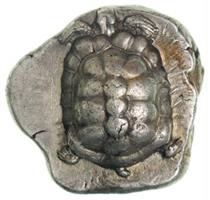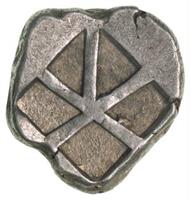Coins in ancient Greece
Ever wonder why our coins today look the way they do? How the basis for the decoration of coins developed? Today,
most bills and coins alike share the common pattern of depicting the profile or bust of a ruler on the obverse, while the
reverse bears the image of an important civic symbol - be it a building or an animal. This tradition began with
the ancient Greeks.
From about the eighth century B.C. and even after the Greeks were absorbed into the kingdoms of Alexander the Great and
his successors, the Greek world was characterized by the polis, the city-state, of which there were
several hundred. Each polis consisted of a city and its surrounding countryside, and each had its own form of government,
its own patron deities and heroes and sanctuaries dedicated to them, and its own distinctive economy.
The poleis were fiercely independent, even when they were ruled by tyrants or dominated by Hellenistic kings, and their
coins are eloquent testimony to their autonomy. Almost from their earliest appearance Greek coins used a combination of
figures, symbols, and inscriptions to emphasize the independence and individuality of the poleis, depicting their patron
deities and heroes, products, and even visual puns on the cities' names.
The historical portraits on early Greek coins are a significant contribution to the history of art. Within them they reflect
the highest ideals of the traditional art of the day, as well as provide exact replicas of images of many sacred and
important buildings and temples, making their historical importance incalculable. From their very beginnings, coins were
not merely chunks of metal to be used in commerce, but important tools for the expression of art and the
communication of religious devotion and civic pride.
The pre-Numismatic Age
In order to facilitate trade and business transaction, various metallics (diverse in weight and shape) circulated among the
then known world in the pre-numismatic age. "Tripodes", "axes", "skewers" are among the names given to the
above mentioned objects. The earliest coins appeared simultaneously in two places;
China and western Asia Minor in the late seventh century B.C. Whether they were invented by the Ionian Greeks or by the
neighbouring Lydians will probably never be known, but it was the Greeks who spread coinage throughout the Mediterranean,
introducing it to many non-Greek peoples with whom they came in contact.
At first, Greek coins were stamped with designs, which numismatists call "types," only on the front or obverse, and the
reverse carried the impression of the punch used to stamp the metal into the obverse die. By the end of the sixth
century the punch also carried a die for the reverse, and from this point onward most Greek coins had types on
both sides. It is not always clear what dictated the choice of types, but it soon became almost universal practice to use
types and inscriptions that identified the polis issuing the coins.
Numismatic System of Aegina
The first silver coins, whose shapes were either elongated or round, were minted on the island of Aegina by order of
the benevolent tyrant of Argos, Pheidon. He was the Head of the Amphyctiony (the confederation of the 7 Doric Greek city-States
that included Aegina) and the first to detitleine weights and measures for both liquids and dry goods. The inhabitants of
Aegina were famous as merchants and seafarers; they carried on a lively trade with the Ionians and since the Ionian coins
facilitated trade remarkably, the Aegians soon adopted coinage. The motif on the coins of Aegina was a sea turtle - the island
was a major sea power, and the turtle seemed to be an appropriate symbol. The turtle-coins of Aegina were widely used
and very popular. They were commonly known as "turtles" - a slang expression still used in German language, today
meaning "a few bucks", or "peanuts."

The Aeginitian numismatic system
- 1 Talent = 60 Mnas
- 1 Mna = 100 Drachmas
- 1 Drachma = 6 Obols
One of Pheidon's actions, in accordance with the religious believes of those days, was his offering to the goddess Hera
(at the temple in Argos). It was a collection of various small metal objects used in the pre-coinage times, but he also offered,
as a symbol of the new "numismatic" period which begins with his reign, one of the first coins minted in Aegina. This offering
was discovered in 1906 during the excavations of the Argive Heraeum and is now held at the Numismatic Museum in Athens.
Coins expand throughout the Mediterranean
The coin standard of Aegina was prevailing in the whole Aegean from about 600 to 450 BC. The practice of minting
coins was directed westwards and the silver 'colts' of Corinth, named after the Pegasus design on the front, were
influential in the development of coinage in north-western Greece and also in southern Italy and Sicily. As the Greek world
was divided into at least a hundred self-governing cities and towns (in Greek, poleis), and most of these issued their own
coins, different weight standards co-existed. However, some coins circulated widely beyond their poleis, indicating that
they were being used in inter-city trade; the first example appears to have been the silver drachm of Aegina.
In about 510 BC Athens began producing a fine silver tetradrachm (four drachm) coin. The Athenians of
the pre-numismatic era employed the obol as a currency, which was nothing more than a small iron rod. About six obols could
fit into the average adult grasp, and therefore six obols became the drachma by a rule of grammar. The word derives quite
logically from the Greek verb dratto - to grasp. Thus drachma in old Greek really means "the graspable" (or a
handful). The tetradrachm, with the owl's head stamped on it, was the first great trade coin in the world
circulating from 510 to 38 BC. The owl was the attribute of the city goddess Athena, the goddess of wisdom. This image is
found today on the national side of the Greek 1 euro coin. By far the largest number of these
coins was minted around the middle of the 5th century BC, when the Greek cities in the Delian League had to send tribute
payments of 5000 talents to Athens. These tribute payments were used in the main for building the Pantheon and other
large buildings.


As Athens and Aegina were hostile, the tetradrachm was minted to a different weight standard, the "Attic" standard drachm
of 4.3 g. Over time, Athens' plentiful supply of silver from the mines at Laurion and its increasing dominance in trade made
this the pre-eminent standard. With the growth of Athenian power the Attic coin standard became predominant. And with Athen's
rise to becoming an ancient super power, Aegina lost its significance as a sea force. Since then (mid-5th century BC) Aegina
did not mint sea turtles on its coins any more, but tortoises. This change symbolized the loss of Aegina's naval power. The
coin shown here was minted at the time after the decline already, since it depicts a tortoise.
As tetradrachms and other coins circulated more widely, coins of other cities came increasingly to be minted to the same
weight standard although marked with the symbols of the issuing city. This is rather like today's
Euro coins, which are recognisably from a particular country, but usable all over the
Euro zone.
From these major centres of production coinage spread throughout Greece. The cities of Euboea: Carystus, Chalcis and
Eretria; Boeotia and in central Greece; in the west; and various cities and tribes in Macedonia and Thrace in the north
all produced significant issues of coinage before 480 bC. Northern Greece contained rich deposits of silver, and this
region produced some especially large silver coins, mainly minted for export east to the heartlands of the Persian Empire,
where silver was more highly valued: parts of northern Greece were under Persian rule during the reigns of the Persian
Kings Darius I (521-486 bc) and Xerxes (486-465 bc).
Before long drachmas were being minted at Greek settlements in southern Italy, with the result that the Romans switched
from using bronze bars to coins in about 300 BC. And at roughly the same time Philip of Macedonia and his son Alexander
the Great were producing huge quantities of coins to finance their military conquests.